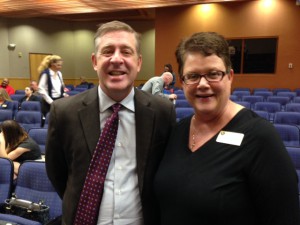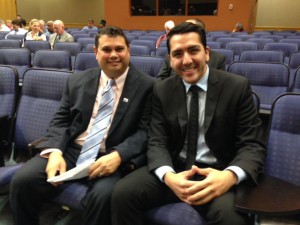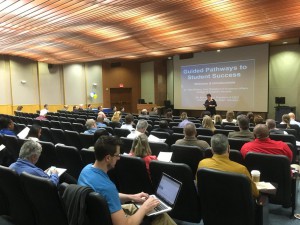How can universities and colleges help students graduate faster without compromising the quality of their education?
College of Southern Nevada faculty and staff heard from one of the leading innovators in higher education today about the latest key strategies that progressive states are employing. Dr. Bruce Vandal, senior vice president of results at Complete College America, a nonprofit working with more than 30 states to increase college completion, was on campus to talk about some game changing strategies for the Mission Achieves: Guided Pathways for Success Workshop.

Dr. Bruce Vandal, senior vice president of results at Complete College America, and CSN interim Vice President of Academic Affairs Hyla Winters at the October 29 Guided Pathways for Success Workshop hosted by CSN, Complete College America and United Way of Southern Nevada.
The good news is that CSN is on track and already working on a number of these.
On Thursday, Vandal led a conversation with CSN faculty, staff and community leaders, as part of Mission Achieves – the United Way of Southern Nevada-led and Lumina Foundation-sponsored initiative to increase the number of Nevada college graduates from 30 percent to 60 percent by 2025. CSN, through United Way of Southern Nevada’s Mission Achieves, recently received a “Game Changer” award by Complete College America to assist CSN faculty and staff in their work with guided pathways. This work will ultimately help college students complete their degree programs in a more timely manner. According to Complete College America, the average student seeking an associate degree completes 81 credits, while 60 is the standard for graduation. CSN, in partnership with Complete College America and United Way of Southern Nevada, then put together the Oct. 29 Guided Pathways for Success Workshop to hold a broader discussion on Guided Pathways and other student success measures.

United Way of Southern Nevada CEO Bob Morgan and Senior Director Nelson Araujo discuss the importance of college completion at the October 29 Guided Pathways for Success Workshop hosted by CSN, Complete College America and United Way of Southern Nevada.
Easy to understand maps that tell students semester, by semester, what they should take and when, were the central topic. CSN has created what’s called a Guided Pathway for each degree program, including a map for full-time students and one for part time students taking at least nine credits, that provides the most effective route to commencement.
“These maps help students avoid courses that do not count toward their degrees, which can cost them time and money and may lead some to drop out all together,” said Interim Vice President of Academic Affairs Dr. Hyla Winters. “They put students on the right path and allow them to have an expectation of what courses are offered and when.”
Vandal highlighted a recent survey that found at least 53 percent of undergraduates regret at least one academic decision during their college career. Pathways can help.
“We should be thinking about helping students make initial choices of what they want to do, helping them make informed choices about what they will do and then ultimately getting them to see it through,” Vandal said.
The maps are currently located on the CSN website and CSN faculty and staff are working to use them to ensure the right courses and the right number of sections are offered each semester. They will also appear in the 2016-17 course catalog.

CSN interim Vice President of Academic Affairs Hyla Winters at the October 29 Guided Pathways for Success Workshop hosted by CSN, Complete College America and United Way of Southern Nevada.
“You have absolutely captured in my mind what is the back bone of an effective systematic strategy that is the academic map,” Vandal told CSN faculty and staff. “It is not as simple as here is the map that is just a tool for students. It is a tool for everyone and increases understanding.”
Other effective game-changing strategies being employed in other states that Vandal highlighted included meta majors, general degree plans specific to a field such as the arts or health sciences, that give undecided students a taste of an overall field, and proactive advising that utilizes advanced technology to help the college connect with students showing signs of academic distress during the semester.
